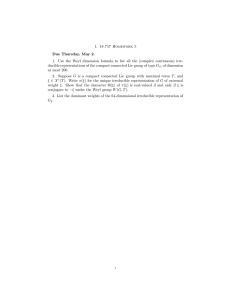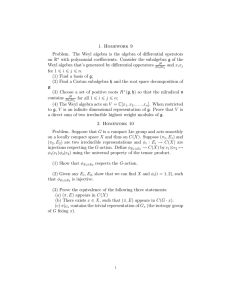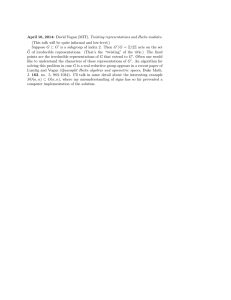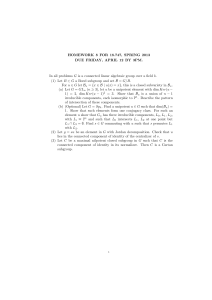BRANCHING LAWS AIM LECTURES JULY 2003 BY PETER TRAPA
advertisement
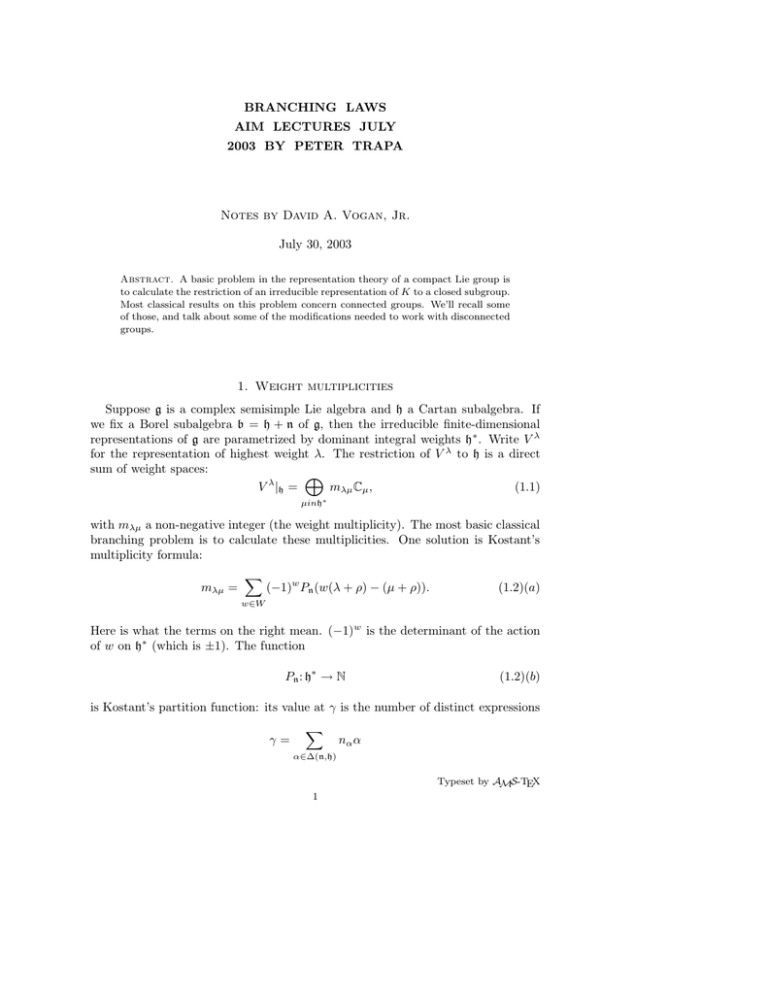
BRANCHING LAWS
AIM LECTURES JULY
2003 BY PETER TRAPA
Notes by David A. Vogan, Jr.
July 30, 2003
Abstract. A basic problem in the representation theory of a compact Lie group is
to calculate the restriction of an irreducible representation of K to a closed subgroup.
Most classical results on this problem concern connected groups. We’ll recall some
of those, and talk about some of the modifications needed to work with disconnected
groups.
1. Weight multiplicities
Suppose g is a complex semisimple Lie algebra and h a Cartan subalgebra. If
we fix a Borel subalgebra b = h + n of g, then the irreducible finite-dimensional
representations of g are parametrized by dominant integral weights h∗ . Write V λ
for the representation of highest weight λ. The restriction of V λ to h is a direct
sum of weight spaces:
M
mλµ Cµ ,
(1.1)
V λ |h =
µinh∗
with mλµ a non-negative integer (the weight multiplicity). The most basic classical
branching problem is to calculate these multiplicities. One solution is Kostant’s
multiplicity formula:
mλµ =
X
(−1)w Pn (w(λ + ρ) − (µ + ρ)).
(1.2)(a)
w∈W
Here is what the terms on the right mean. (−1)w is the determinant of the action
of w on h∗ (which is ±1). The function
Pn : h ∗ → N
(1.2)(b)
is Kostant’s partition function: its value at γ is the number of distinct expressions
γ=
X
nα α
α∈∆(n,h)
Typeset by AMS-TEX
1
2
NOTES BY DAVID A. VOGAN, JR.
of γ as a non-negative integer combination of positive roots. There are many
proofs of Kostant’s formula, using for example the BGG resolution of V λ , or the
smoothness of the flag variety. A very algebraic reference is [Hump].
Knowledge of weight multiplicities leads directly to solutions of many other
branching problems. An example of a problem that it does not solve directly is
this: calculate the representation of W on the zero weight space of V λ . The heart
of the difficulty is that the group W (or the normalizer of H in G) is disconnected.
Before moving to other topics, notice that two basic ingredients in Kostant’s formula are the Cartan-Weyl parametrization of representations by dominant weights,
and the action of W on weights.
2. K multiplicities.
Suppose G is a real reductive group with maximal compact subgroup K and
complexified Lie algebra g. If X is a (g, K)-module of finite length, then by analogy
with (1.1) we have
M
X|K =
(2.1)
mλX E λ ,
b
λ∈K
with mλX a non-negative integer. The fundamental branching problem in this setting is computation of mλX . Here is a way to do that. Suppose for definiteness
that X is irreducible. Write Par for the (finite) set of Langlands parameters for
representations of infinitesimal character equal to that of X. To each δ ∈ Par there
is associated a “standard Harish-Chandra module”
ν
M
X(δ) = IndG
M AN (Xds ⊗ e ⊗ 1).
(2.2)(a)
M
Here Xds
is a Harish-Chandra module for M in the limits of the discrete series,
and ν ∈ a∗ . Each such standard module has a unique Langlands subquotient X(δ).
(Uniqueness of the Langlands subquotient depends on choosing exactly the right
parameter set; it is not true for arbitrary representations of the form (2.2)(a).) The
irreducible modules X(δ) are inequivalent, and every irreducible Harish-Chandra
module of the same infinitesimal character as X is equivalent to one of them.
The Kazhdan-Lusztig conjectures (which are theorems at least for connected
linear groups) allow us to write
X
mγδ X(δ),
(2.2)(b)
X(γ) =
δ∈Par
with mγδ an integer given by a reasonable1 algorithm (see the talk by Fokko du
Cloux).
The problem of computing X|K is reduced by (2.2)(b) to the problem of computing each X(δ)|K . Because of (2.2)(a),
M
X(δ)|K = IndK
M ∩K (Xds |M ∩K ).
Because of Frobenius reciprocity, this calculation in turn can be broken into two
parts:
M
(1) compute Xds
|M ∩K ; and
λ
b
(2) compute V |M ∩K for every irreducible representation λ ∈ K.
1 The definition of “reasonable” shifted rather drastically on the occasion of the publication of
the original article of Kazhdan and Lusztig.
BRANCHING LAWS AIM LECTURES JULY 2003 BY PETER TRAPA
3
The first of these problems can be approached using the Blattner formula, which is
closely analogous to (and as computable as) the Kostant multiplicity formula (1.2).
There are complications arising from the disconnectedness of M , but never mind.
We will therefore concentrate on the second, which is entirely a branching problem
for compact groups. Here are two illuminating examples.
Example 2.3. Suppose G = U (p, q), so that K = U (p) × U (q). The choices for
M are parametrized by a non-negative integer a less than or equal to both p and
q. Then
M ∩ K = U (p − a) × U (1)a∆ × U (q − a).
This is the subgroup of [U (p − a) × U (1)a ] × [U (1)a × U (q − a)] obtained by taking
the diagonal copy of U (1) in each of the a copies of U (1) × U (1). Branching to
these subgroups is easily handled by mild generalizations of Kostant’s multiplicity
formula.
Example 2.4. Suppose G = O(p, q), so that K = O(p) × O(q). Some of the
possibilities for M (there are more) are parametrized by a non-negative integer a
less than or equal to both p and q. Then
M ∩ K = O(p − a) × O(1)a∆ × O(q − a).
Formally this example looks very similar to the preceding one, but technically it is
very different: the subgroup M ∩ K has (usually) 2a+2 connected components, so
that one cannot expect to get a branching law using only Lie algebra ideas.
Example 2.5. Suppose G is the split real linear group of type E8 , so that K =
Spin(16)/{1, ²}. If M AN is the Borel subgroup of G, then M = M ∩ K ' (Z/2Z)8 .
At most 16 of the 256 elements of M belong to a common maximal torus of K, so
again Lie algebra methods cannot provide much help with the branching problem.
3. Branching for connected compact groups.
In this section we will recall Kostant’s general branching theorem for connected
compact Lie groups. We can work entirely with Lie algebras; so fix a complex
reductive Lie algebra g, and let k be a subalgebra reductive in g. (The connection with compact groups appears when g and k are complexified Lie algebras for
compact connected groups G ⊃ K.) There is an ad(k)-invariant complement p for
k:
g = k ⊕ p.
(3.1)(a)
Choose a Cartan subalgebra t ⊂ k, and extend it to a Cartan subalgebra h of g:
h = t ⊕ (h ∩ p).
(3.1)(b)
There is a natural restriction map
res: h∗ → t∗ ,
λ 7→ λ.
(3.1)(c)
Define
l = gt ,
(3.1)(d)
4
NOTES BY DAVID A. VOGAN, JR.
a Levi subalgebra of g (corresponding to the roots of h in g that restrict to zero on
t). Choose a parabolic subalgebra q = l + u of g in such a way if α and β are any
two roots of h in g, then
α=β
and
α ∈ ∆(u, h) ⇒ β ∈ ∆(u, h).
(3.1)(e).
This is certainly possible to arrange. Finally, choose
∆+ (g, h) ⊃ ∆(u, h).
(3.1)(f ).
We need a little notation about the Weyl group. For w ∈ W (g, h) = W , define2
∆w = {α ∈ ∆+ | w−1 α < 0}.
(3.2)(a)
W 0 = {w ∈ W | ∆w ⊂ ∆(u, h).
(3.2)(b)
Now define
0
The set W is the set of (minimal length) coset representatives for W (l, h) in W ;
that is, multiplication defines a bijection
W (g, h) = W (l, h) × W 0 .
(3.2)(c)
Theorem 3.3 (Kostant). Suppose V λ is a finite-dimensional irreducible representation of g of highest weight λ ∈ h∗ , and V ν is a finite-dimensional irreducible
representation of k of highest weight ν ∈ t∗ . Then the multiplicity of V ν in V λ |k is
X
(−1)w dλ (w)Pu∩p (w(λ + ρ) − ρ − ν).
w∈W 0
Here dλ (w) is the dimension of the irreducible representation of l of highest weight
w(λ + ρ) − ρ; and the partition function
Pu∩p : t∗ → N
counts expressions in terms of the weights of t on u ∩ p.
Another approach to this branching problem is due to Patera, Sharp, Moody,
and McKay. The idea is to begin with the weight multiplicity formula
Vλ =
X
mµ (W · µ),
µ∈h∗ dominant
then to compute the branching
(W · µ)|t =
X
mµ0 (Wk ) · µ0 ,
µ0 ∈t∗ dominant
and then to deduce multiplicities of representations of k.
2 In the lecture, w was σ, and ∆
w was written Wσ . This notetaker was able to write that
down, but finds himself unable to commit it to TEX.
BRANCHING LAWS AIM LECTURES JULY 2003 BY PETER TRAPA
5
4. Disconnected compact groups.
We mentioned at the end of section 1 that two of the basic ingredients in the
b by weights,
Kostant multiplicity formula are the Cartan-Weyl parametrization of K
and the action of the Weyl group on the parameter space. Here we will begin to
extend these ingredients to disconnected groups.
So assume that K is a compact Lie group, possibly disconnected. Write k for the
complexified Lie algebra of K, T0 for a maximal torus in the identity component
K0 , and
b=t+n
(4.1)
for a Borel subalgebra of k.
Definition 4.2. The large Cartan subgroup of K corresponding to b is
T + = {t ∈ K | Ad(t)(b = b} = NK (b).
The small Cartan subgroup is
T − = {t ∈ K | Ad(t)|t is trivial} = ZK (T0 ),
the centralizer in K of T0 . A general Cartan subgroup is any group T such that
T − ⊂ T ⊂ T +.
If T is any Cartan subgroup of K corresponding to b, then there is a well-defined
character 2ρ of T ,
2ρ(t) = det Ad(t)|n ,
(4.3)(a)
the determinant of the adjoint action of T on n. Despite the suggestive notation,
the character 2ρ need not have a square root. We need such a square root, so we
introduce the group
Te = ρ cover of T = {(t, z) ∈ T × C× | 2ρ(t) = z 2 }.
(4.3)(b)
Projection on the first factor defines a two-to-one group homomorphism
π: Te → T,
π(t, z) = t.
(4.3)(c)
The kernel of π consists of the identity and ² = (1, −1). There is a short exact
sequence
π
1 −→ {1, ²} −→ Te−→T −→ 1.
(4.3)(d)
Projection on the second factor defines a character that we call ρ:
ρ: Te → C× ,
ρ(t, z) = z.
(4.3)(e)
The differential of ρ is equal to one half the differential of 2ρ, or one half the sum
of the roots of t in n. Furthermore ρ is a genuine character of Te, by which we mean
that ρ(²) = −1.
6
NOTES BY DAVID A. VOGAN, JR.
Definition 4.4. Suppose that Te is the ρ cover of T defined in (4.3). An irreducible
representation χ of Te is called genuine if χ(²) = −I. (This is equivalent to assuming
that χ does not factor through π to the quotient group T .) The differential of χ
is a completely reducible representation of the Lie algebra t, and therefore a direct
sum of various weights in t∗ . The representation χ is called dominant if one (or,
equivalentally, all) of these weights is dominant. It is called regular if one (or,
equivalently, all) of these weights is non-zero on every coroot of t in k.
Theorem 4.5. Suppose K is a compact Lie group and T + is a large Cartan subgroup. Let Tf+ be the ρ covering of T + (cf. (4.3)). Then there is a natural bijection
b of irreducible representations of K, and the set of genuine dombetween the set K
inant regular irreducible representations of Tf+ .
Describing this bijection is fairly easy. If V is an irreducible representation of
K, then the subspace V n of highest weight vectors is an irreducible representation
of T + . This provides a bijection
b ↔ dominant irreducible representations of T + .
K
Next, ρ is a genuine irreducible one-dimensional representation of Tf+ . It follows
that tensoring with ρ provides a bijection
irreducible representations of T + ↔ genuine irreducible representations of Tf+ .
This bijection identifies dominant representations on the left with dominant regular
representations on the right. Combining these two bijections gives the theorem.
You may wonder why we introduced the covering, which so far has served only
to complicate the statement and proof of Theorem 4.5. The reason is that the
covering will make possible a statement of the Weyl character formula, in which both
numerator and denominator are genuine functions on Tf+ . (A “genuine function”
is one sent to its negative under translation by ².) The actual lecture concluded
with a precise and correct statement of the Weyl character formula on the small
Cartan subgroup T − . The notes will conclude instead with a statement of the Weyl
character formula on T + more or less equivalent to the one described in [Vorange].
Definition 4.6. Suppose K is a compact Lie group, b is a Borel subalgebra of k,
and T + is the normalizer of b in k. Then the homogeneous space K/T + is naturally
identified with the flag variety B of all Borel subalgebras of k. An element of k ∈ K
is called regular for K if some (equivalently every? I’m not sure what to guess)
fixed point of k on B is regular: that is, if the induced action of k on the tangent
space at the fixed point does not have 1 as an eigenvalue.
An element t ∈ T + is called regular for K if the adjoint action Ad(t)|n does not
have 1 as an eigenvalue. (In order for this definition to be nicely consistent with
the one above, one needs to be able to replace “some” by “every.”) Regularity in
T + is equivalent to the condition
det(I − Ad(t)|n ) 6= 0.
The Weyl denominator is the function
∆(t̃) = ρ(t̃)−1 det(I − Ad(π(t̃))|n )
BRANCHING LAWS AIM LECTURES JULY 2003 BY PETER TRAPA
7
on Tf+ . It is non-zero exactly on the preimages of regular elements of T + .
The (unchecked) hope is that regular elements in T + are dense in T + , and that
regular elements of K are dense in K, and that every conjugacy class in K meets
T + . None of this should be very hard; the danger is that it’s false.
We turn now to the Weyl character formula. Just as for connected K, the formula
expresses the trace of a regular element t ∈ T + as a quotient of two terms, each of
which depends on a preimage of t in Tf+ . (Changing the chosen preimage changes
the sign of each term, so the quotient depends only on t.) The denominator is the
Weyl denominator of Definition 4.6. The numerator is (roughly speaking) a sum
over the Weyl group of T0 in K0 . What makes life complicated is that this Weyl
group does not act on T + . The solution (roughly speaking) is simply to throw away
the terms that don’t make sense.
Here are the details. Recall that we are fixing b = t+n. Write n− for the opposite
nil radical (which is automatically preserved by T + ). Suppose w ∈ W (k, t). Then
w defines a second Borel subalgebra
bw = t + n w ,
(4.7)(a)
+
corresponding to w(∆ (k, t). This new Borel subalgebra defines a large Cartan
subgroup
T +,w = NK (bw ).
(4.7)(b)
The identity component of T +,w is the same torus T0 as for T + , but the other
components can be different. It’s not difficult to see that
nw = (n ∩ nw ) ⊕ (n− ∩ nw ),
(4.7)(c)
and therefore that
T + ∩ T +,w = {t ∈ T + |Ad(t) preserves n ∩ nw }.
+
+,w
(4.7)(d)
The representations of T ∩ T
on n ∩ n and on n ∩ n
are contragredient.3
+
+,w
It follows that on their common domain T ∩ T
, the two characters 2ρ and 2ρw
differ by the square of a determinant:
−
w
2ρw (t) = 2ρ(t) · [det(Ad(t)|n− ∩nw )]2
−,w
(t ∈ T + ∩ T +,w ).
(4.7)(e)
+
This fact provides a natural isomorphism between the ρ covering of T ∩ T
the ρw covering,
(t, z) 7→ (t, z · det(Ad(t)|n− ∩nw )
+,w
and
(t ∈ T + ∩ T +,w ).
In this way we can regard ρw as a character of the ρ covering (T + ∩ T +,w )∼ .
We can now state the Weyl denominator formula
X
∆(t̃) =
(−1)w ρw (t̃).
(4.8)
w∈W (k,t)
t∈T + ∩T +,w
Suppose now that χ is a genuine irreducible representation of T + . Since it’s the
end of the day, I will merely assert confidently that there is a natural way to define a
genuine representation χw of (T + ∩ T +,w )∼ . (The idea is to twist χ by conjugation
by an element of K0 defining the Weyl group element w. This conjugation will
carry T + ∩ T +,w into T + .)
3 This is a somewhat subtle point, even in the simplest case n w = n− . One way to see it is by
introducing appropriate symplectic forms, and using the fact that the determinant of a symplectic
linear map is one.
8
NOTES BY DAVID A. VOGAN, JR.
Theorem 4.9 (the Weyl character formula). Suppose T + is a large Cartan subgroup of a compact Lie group K, χ is a genuine dominant irreducible representation
of Tf+ , and V χ is the corresponding irreducible representation of K. Suppose t is
a regular element of T + , and that t̃ is a preimage of t in the ρ covering Tf+ . Then
the character of V χ at t is
Θχ (t) =
X
w∈W (k,t)
t∈T + ∩T +,w
(−1)w χw (t)
/∆(t̃).
This formula could be proved using the Atiyah-Bott-Lefschetz fixed point formula.4
References
[Hump]
J.E. Humphreys, Introduction to Lie Algebras and Representation Theory, SpringerVerlag, Berlin-Heidelberg-New York, 1972.
[Vorange] D. Vogan, Unitary Representations of Reductive Lie Groups, Annals of Mathematics
Studies, Princeton University Press, Princeton, NJ, 1987.
4 But let us not forget the possibility that this tissue of surmise and hypothesis has no basis in
reality.

